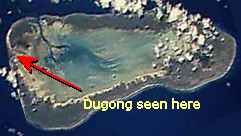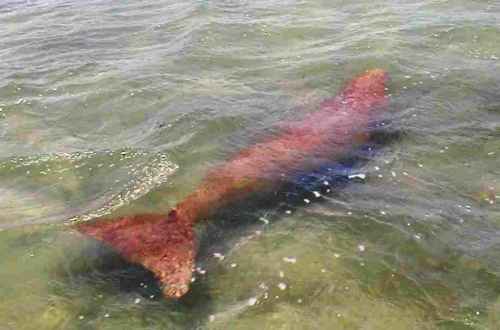Dugongs seen in AldabraIn the year (2001) dugongs have been seen in the Aldabra Atoll (belonging to the Seychelles) on four occasions since August 2001.
Most of the time it has been one dugong but on the third occasion two dugongs were spotted in the same area. The dates of the sightings were on 02/08/01, 03/08/01, 01/10/01 and 12/10/01.  Aldabra is a huge atoll half way between the Seychelles and the Comoros Islands, in the open Indian Ocean. Aldabra is a huge atoll half way between the Seychelles and the Comoros Islands, in the open Indian Ocean.Size 35,000ha, of which terrestrial: 18,800ha; mangrove: 2,000ha; marine: 14,200ha), almost uninhabited, and is, between others, home to 150,000 giant land tortoises. |

PRESS RELEASE16 October 2001 RARE DUGONG SIGHTINGS ON ALDABRAThe Dugong, commonly known as the sea cow is one of the worlds most interesting and endangered species.These marine mammals which once roamed the waters of Seychelles in great abundance, just might be making a come back. Recent sightings of this remarkable creature by Aldabra Research Station staff have sparked much excitement by the international scientific community. International news agency Sirenews have already taken up the story in what was described as a sensational report. Four sightings have been recorded thus far at Aldabra since the 2nd August 2001, the most recent on the 12th October in shallow lagoonal waters near the mangroves of an area known as Bras Monsieur Clairemont. The dugongs are believed to be adults of around 2.5 – 3 metres long. All the animals have been spotted in the same area and are usually solitary. Although there have been previous sightings of Dugongs around Aldabra multiple sightings in such a short period of time is unheard of. It is believed by some local experts that they may have migrated to the atoll during the North West monsoons. Dr. Ian Swingland Emeritus Professor of Conservation Biology Founder of the Durrell Institute of Conservation and Ecology in the UK, reported that during the mid 1970’s the Royal Society Research team sighted Dugong on several occasions in calm waters in the western end of the lagoon during the dry season. The sightings were documented by Professor David Stoddart’s “Biography and Ecology of the Seychelles Islands” published in 1984. A local expert on the ecology of Aldabra, Antonio Constance also known as Mazarin, remarked that he had also spotted Dugongs on occasion long before the Royal Society’s activities on Aldabra. Dugongs once occurred off all or most of the islands of Seychelles as well as Mauritius but were apparently wiped out early last century. The last large dugong herds were seen in the mid-1800’s. The animals were largely exploited for their meat, oil, hides, and bones, which has led to their massive decline worldwide. Australia’s
Great Barrier Reef, the stronghold of the species, the population has declined
by 50 – 80% since 1986.The World
Conservation Union (IUCN) would categories, this level of decline of the
species as critically endangered within the region, a matter that is now being
addressed by environmentalist. Currently, Dugongs are listed world wide as endangered under the
Endangered Species Act of the USA. In response to this important sighting Seychelles Islands Foundation feel it is crucial to initiate a scientific research project to study the dugong on Aldabra and contribute to its conservation worldwide. As a non-profit making organization, budgetary constraints would not allow immediate implementation of a project of this kind. The Foundation is currently seeking a donor for this project locally and internationally. Angela Valente (Seychelles Islands Foundation)
Newsflash
A juvenile dugong has been sighted at Ile Esprit in the lagoon of Aldabra on 23 October 2003, almost exactly 2 years after the first sighting described above. |